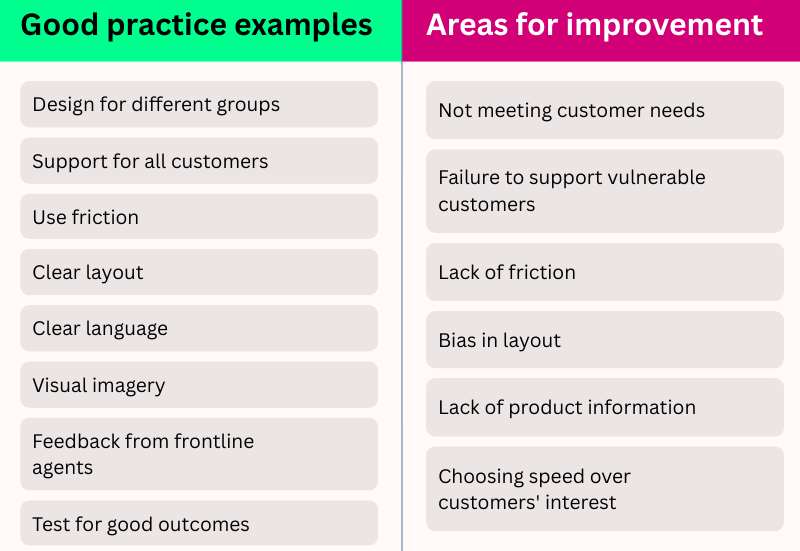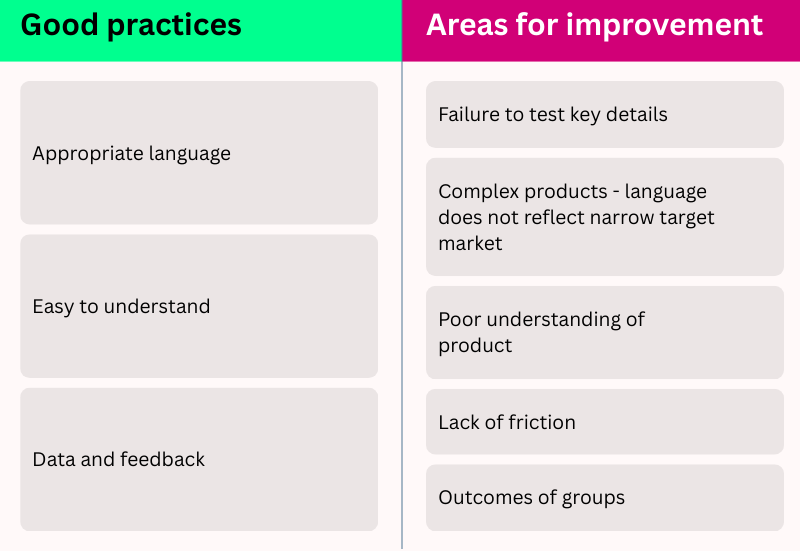The FCA introduced the Consumer Duty initiative to bring about a fairer, more consumer-focused and level playing field in the Financial Services Market.
They expect firms to place customers’ interests at the centre of their businesses and to focus on the delivery of good customer outcomes.
Below are all the latest Consumer Duty updates that lenders need to be aware of:
Latest update: Digital Design in Online Journeys & Customer Outcomes
The FCA recently carried out a review to establish how firms acquire customers through their digital channels and how they are delivering good customer outcomes, in line with the requirements of Consumer Duty.
Summary of key findings:
-
The main finding from their review was that the design of digital platforms can both influence a customer’s behaviour in a specific direction, and their understanding of products and features.
-
What this means is:
-
Design can be an enabler of good consumer outcomes,
-
But, if not handled well, design can also drive customers toward making quick or ill-informed decisions that may not be in their best interests, or consistent with the FCA’s Consumer Duty expectations.
-
Consequently, the FCA is encouraging firms to consider customer understanding and decision making in their design of customer journeys, with a view to making any changes to existing processes where necessary.
Detailed look at the review
The FCA’s review covered the following 4 focus areas:
-
Design aspects
-
Customer groups
-
Testing and quality assurance
-
Management information and oversight
Design aspects

Recommendations for design aspects good practice:
-
Design digital journeys that meet the needs of different customer groups identified within the firm’s target market.
-
Ensure that adequate levels of support are provided to all customers, including those with characteristics of vulnerability.
-
Consider whether adding friction can help customers with their decisions and how it may affect customer choice.
-
Ensure a clear layout of product offerings that illustrate key features. Ensure customers are aware of the different steps within a journey before the sign-up process.
-
Use plain English and short sentences to aid understanding.
-
Use images and add videos to the digital journey, to help explain key information about products and how they work.
-
Include frontline agents in the design of digital journeys and support, allowing them to provide feedback based on real customer interactions.
-
Testing and quality assurance ensure good customer outcomes. Consider how the speed of digital journeys and timeliness of key information affect outcomes in your testing.
Intuitive by design, supportive by nature
Best practice built into every Lenvi PF1 experience.

Customer groups
A firm’s target market is likely to include a range of customers with a variety of needs and characteristics. There are also a range of circumstances that can impact a customer’s understanding of products and services, such as financial literacy.
The FCA’s feedback on this matter focused on firms being required to understand these needs and characteristics, and the objectives of customers in the target markets, and use this knowledge to inform the design of product and customer journeys.
In this regard, they set out the following descriptors of best practice:
-
Understand your target market - Target market analysis can help firms to better understand the different needs of customer groups, including the needs of customers acquired through different channels, those who need additional support, and those with characteristics of vulnerability.
-
Adequate support for all customers - Firms operating solely through a digital platform who make sure they can meet their customers' support needs. This includes ensure customers dealing with non-standard issues, with characteristics of vulnerability, and customers acquired through different channels, such as third-party referrals, are given more support to understand products and services.
-
Identify vulnerable customers - Firms can identify customers with characteristics of vulnerability and those requiring additional support through digital channels. Firms can review the effectiveness of their support channels through testing activity and customer insights.

Testing and quality assurance
Already alluded to earlier in the review, testing and quality assurance is a key area for ensuring that digital design of customer journeys is fit for purpose and meets the requirement of Consumer Duty.
Examples of good practice in this area include:
-
Use of appropriate language – Firms who extensively test the language used in their website, apps, and promotions – feeding this into product design and governance.
-
Easy to understand – Firms that excel in area assess how their communications are understood.
-
Data and feedback – Firms that use quality assurance and data, as well as feedback from frontline agents to improve support and the digital journey.
While areas for improvement included:
-
Failure to test key details such as customer understanding of key product information e.g. fees and features.
-
When simplified language used to does not improve customer understanding, particularly in the case of complex products. Simplicity does not necessarily guarantee clarity.
-
Failure to test whether end-to-end journeys are optimised to ensure customers have the opportunity to view and understand the product fully e.g. when customers cannot view the full page or access different settings.
-
Using testing and assurance activity to better understand the right level of friction needed in digital journeys to ensure that journeys are still efficient but ensure that customers have read and understood the information provided properly.
-
Firms can also test how different customer groups, and their respective journeys, achieve good outcomes.
Discover how Lenvi’s QA team delivers smart, reliable solutions in the delivery of our industry leading software

Management information and oversight
Firms have a duty to monitor and regularly review customer outcomes.
The FCA concluded that digital journeys can support firms in adhering to this due given the significant amounts of data on how customers interact across firms’ apps, websites and financial promotions they produce.
Analytics software can also provide firms with data that gives deep insight into the customer journey. This may include identifying steps on a journey with a high dropout rate (e.g. when customers are required to enter payment details).
In this regard, they found the following areas for improvement for firms:
-
Analyse data on customer journeys - Firms may have access to data that indicates customers are advancing through customer journeys too quickly and not accessing key information, features or help. Analysis of this data could help firms to improve the design of digital journeys and customer outcomes.
-
Use multiple indications to measure success - Firms can be overly reliant on positive online review ratings as an indicator that there are no significant issues and consumers are experiencing good outcomes. While reviews can be a useful indicator, they are unlikely to be sufficient for firms to understand outcomes across their customer base.
Next steps
The FCA have affirmed that they will continue to monitor approaches to digital journeys and app design.
[This page was updated on 1 October, 2025]
Previous updates

In the Financial Conduct Authority’s latest update announced on February 27, 2025, the FCA has removed the expectation for firms to have a designated Consumer Duty champion at Board level.
This change, effective immediately, provides firms with greater flexibility in their governance arrangements while maintaining the focus on consumer outcomes.
The FCA stated that the Consumer Duty, which came into force for open products and services on July 31, 2023, and for closed products and services on July 31, 2024, should now be well-embedded in firms' management discussions, processes, and policies.
While firms are no longer required to have a Duty champion, they can retain the role if they wish to do so.
This development comes as part of the FCA's ongoing efforts to refine and streamline regulatory requirements. However, it's important to note that the fundamental expectations regarding Consumer Duty compliance remain unchanged. Firms are still expected to ensure that the Duty is regularly discussed and considered in all relevant decision-making processes.
Key takeaways from the FCA’s Consumer Duty Board report reviews
On the topic of Consumer Duty and Board responsibilities, the FCA's review of the first Consumer Duty board reports has revealed both progress and areas for improvement across the financial services industry.
The FCA’s review of these reports emphasises the importance of strong governance, customer understanding, and proactive monitoring to improve consumer outcomes.
Findings indicate that many firms, including smaller lenders, must enhance their oversight, ensure board reports contain actionable insights, and develop better methods for assessing customer needs.
However, for many firms, the process of producing their inaugural Consumer Duty Board report was challenging due to the lack of precedent to be able to follow.
While some smaller firms were praised for their innovative approaches, such as utilising real-time missed payment data for early intervention and tailoring services for vulnerable customers, others struggled with data specificity, insufficient focus on vulnerable consumers, and a reactive approach to risk identification.
The FCA acknowledged that resource constraints might impact full implementation, especially for smaller firms, but maintained its expectation for all entities to take proportionate and practical steps towards compliance.
We have no doubt that as firms get more familiar with the production of these reports, the value and actionable insights they produce for their own business, the FCA and the broader industry will only strengthen.
Consumer Duty in the FCA's future strategy
Despite their first relaxation in requirements, the FCA has reaffirmed that Consumer Duty will play a central role in its upcoming five-year strategy, set to be released in spring of this year.
This underscores the regulator's continued commitment to promoting fair consumer outcomes and maintaining high standards in the financial services industry.
The FCA's focus on Consumer Duty is evident in its recently outlined priorities for 2024/25, which include:
-
Embedding Consumer Duty and raising standards: The FCA plans to assess how firms across various sectors are implementing and complying with the Duty.
-
Enhancing understanding of price and value outcomes: This involves ensuring firms use robust analysis to assure themselves and the FCA that they are offering fair value to consumers.
-
Sector-specific priorities: The FCA will focus on areas of concern across retail banking, consumer finance, payments and digital assets, consumer investments, and insurance.
-
Realising the benefits of Consumer Duty: The regulator aims to simplify requirements on retail firms where possible, with next steps expected in the second half of 2025.
Looking ahead
While the FCA has provided firms with more flexibility regarding the Board champion role in this latest update, the importance of Consumer Duty in regulatory priorities remains unchanged.
The Board champion role may no longer be mandatory, but companies may find value in retaining this position to drive ongoing Consumer Duty compliance and champion cultural change.
The FCA's upcoming five-year strategy is expected to provide further clarity on the regulator's long-term vision for Consumer Duty and its role in shaping the financial services landscape.
As the financial services sector continues to evolve, maintaining a strong focus on consumer outcomes will be crucial for firms looking to thrive in this dynamic regulatory environment.







